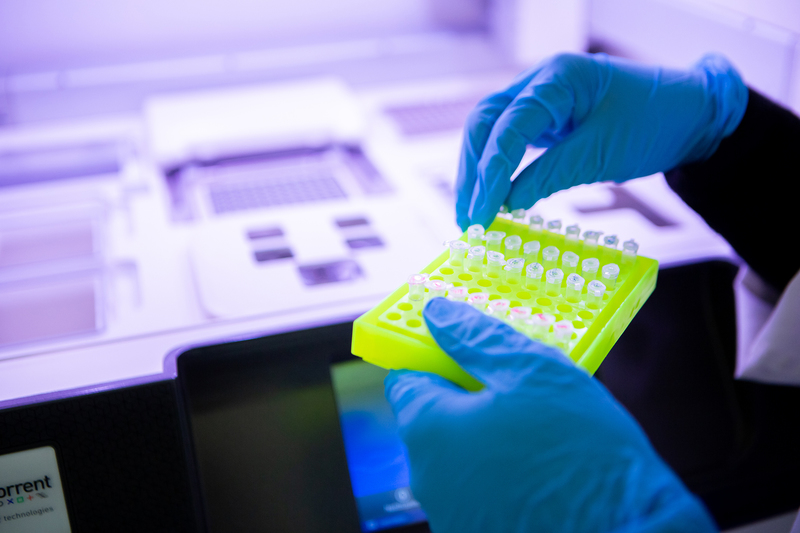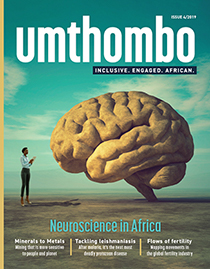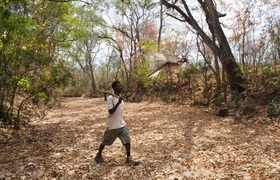Sequencing the future
22 January 2020 | Story Ambre Nicolson. Photo Karin Schermbrucker, Slingshot Media. Read time 5 min.
The African genome is the oldest, and as such, the most diverse in the world. But Africans have largely been under-represented in neurogenetic studies. The University of Cape Town (UCT) Neuroscience Institute is helping to change that through a range of forward-looking, international, collaborative projects on genetics and the nervous system.
Genetics & mental illness
Professor Dan Stein, head of the Department of Psychiatry and Mental Health at UCT, believes that neurogenetics will play an important role in future brain science. He explains that the UCT Psychiatric Neurogenetics Group, co-headed by Drs Shareefa Dalvie and Nastassja Koen, is involved in several projects looking at the genetics underlying mental illness.
One, is the UCT-led, South African Drakenstein Child Health Study. This multidisciplinary South African study is following 1 000 mother–child pairs to investigate a range of factors – including genetic and environmental – that may impact maternal and child health. The researchers have already assessed a subset of the mother–child pairs with panel of markers from across the genome that are relevant to psychiatric disorders, he says.
“We are also working with the international Psychiatric Genomics Consortium,” says Koen. It’s one of several large-scale, multinational psychiatric genomic projects the groups is involved in. “We are working to include our South African samples in their large-scale, genome-wide studies on post-traumatic stress disorder and major depressive disorder.”
This multidisciplinary South African study is following 1 000 mother–child pairs to investigate a range of factors that may impact maternal and child health.
The Psychiatric Neurogenetics Group is also part of a consortium studying early-life environmental effects on disease in young children by looking at epigenetics – heritable changes that aren’t coded in DNA.
“And we’re participating in the Enhancing Neuro Imaging Genetics through Meta-Analysis Network,” continues Koen, “70 institutions from around the world investigating brain structure, function and disease using brain imaging and genomics.”
The group also recently partnered with researchers at the University of Oslo’s Norwegian Centre for Mental Disorders Research to build capacity by training young researchers and conducting research in the field of imaging genomics.
Through this collaboration, students could visit the University of Oslo and get training in imaging genomic analysis by experts in the field, says Dalvie.
Building neuropsychiatric genetic research capacity in Africa is also one of the goals of the UCT Neuropsychiatric Genetics in African Populations (Neuro-GAP) programme. This multi-national research project aims to expand our understanding of the causes of schizophrenia and bipolar disorder in African populations.
Genetics & neuromuscular disease
Other research of the Neuroscience Institute is concerned with neurological diseases that affect people with African ancestry in specific ways. One example is the important research on myasthenia gravis – an uncommon and complex autoimmune disease that causes weakness in skeletal muscles.
Working in collaboration with surgeons has yielded results supporting what they’ve found through their genetic studies.
Professor Jeannine Heckmann and her team in the UCT Division of Neurology have, for the past decade, been investigating the cause of a severe and treatment-resistant form of eye muscle weakness that’s more common among African individuals with myasthenia gravis.
Dr Melissa Nel, who works with Heckmann, says recent research has uncovered new genes and pathways that may be disturbing the healing and energy use of muscles in those susceptible to the condition. Working in collaboration with surgeons has yielded results supporting what they’ve found through their genetic studies.
“Successful collaborations with ophthalmic surgeons have provided opportunities to – for the first time – measure metabolic function and gene expression in eye muscle tissue,” Nel explains.
 This story was published in the fourth issue of Umthombo, a magazine featuring research stories from across the University of Cape Town.
This story was published in the fourth issue of Umthombo, a magazine featuring research stories from across the University of Cape Town. Umthombo is the isiXhosa word for a natural spring of water or fountain. The most notable features of a fountain are its natural occurrence and limitlessness. Umthombo as a name positions the University of Cape Town, and this publication in particular, as a non-depletable well of knowledge.
Read the complete fourth issue online or subscribe and receive new issues in your inbox every few months.
 This work is licensed under a Creative Commons Attribution-NoDerivatives 4.0 International License.
This work is licensed under a Creative Commons Attribution-NoDerivatives 4.0 International License.
Please view the republishing articles page for more information.










